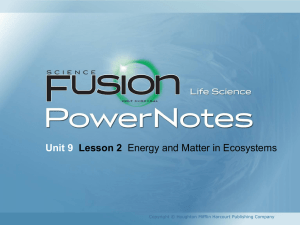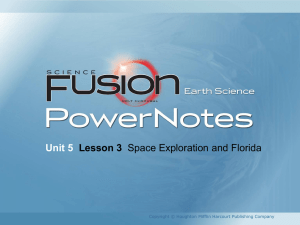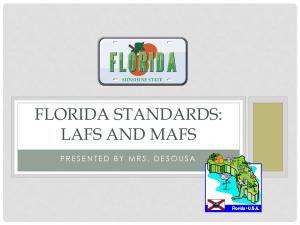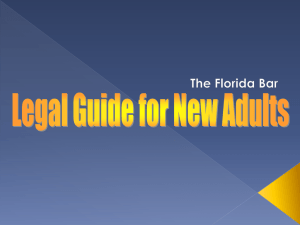6-1_CFLAEAS493558_U08L04
advertisement
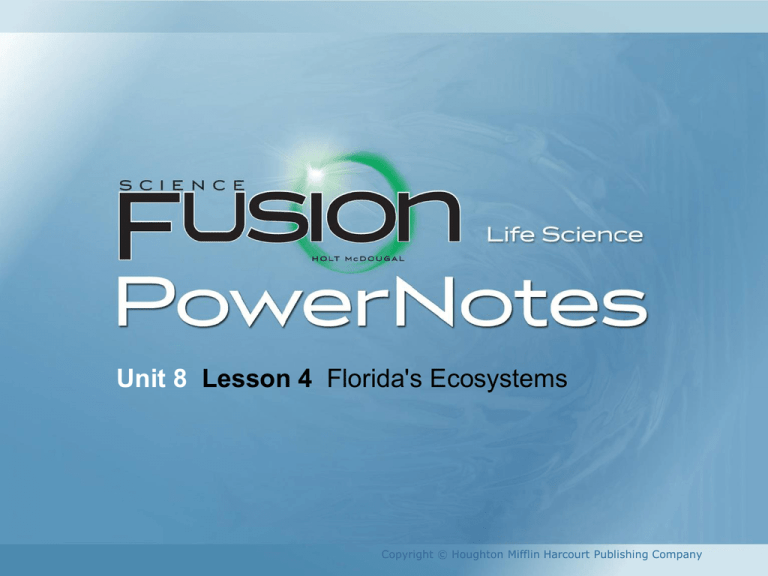
Unit 8 Lesson 4 Florida's Ecosystems Copyright © Houghton Mifflin Harcourt Publishing Company Unit 8 Lesson 4 Florida's Ecosystems Florida Benchmarks • SC.7.N.1.1 Define a problem from the seventh grade curriculum, use appropriate reference materials to support scientific understanding, plan and carry out scientific investigations of various types, such as systematic observations or experiments, identify variables, collect and organize data, interpret data in charts, tables, and graphics, analyze information, make predictions, and defend conclusions. Copyright © Houghton Mifflin Harcourt Publishing Company Unit 8 Lesson 4 Florida's Ecosystems Florida Benchmarks • SC.7.L.17.3 Describe and investigate various limiting factors in the local ecosystem and their impact on native populations, including food, shelter, water, space, disease, parasitism, predation, and nesting sites. Copyright © Houghton Mifflin Harcourt Publishing Company Unit 8 Lesson 4 Florida's Ecosystems Pushing THE LIMIT What limits the size of populations? • When the environment cannot support more individuals, a population will stop growing. • A limiting factor is an environmental factor that keeps a population from reaching its full potential size. Copyright © Houghton Mifflin Harcourt Publishing Company Unit 8 Lesson 4 Florida's Ecosystems What limits the size of populations? • Both living and nonliving environmental factors can limit the size of a population. • Only one factor at a time can limit a population. Copyright © Houghton Mifflin Harcourt Publishing Company Unit 8 Lesson 4 Florida's Ecosystems What limits the size of populations? • Suppose an area has enough food for 500 armadillos and enough water for 1,000 armadillos. Food is a limiting factor. • If the area suddenly had enough food for 2,000 armadillos, the population would not grow to 2,000 armadillos. • Water would be the limiting factor. Only 1,000 armadillos could survive. Copyright © Houghton Mifflin Harcourt Publishing Company Unit 8 Lesson 4 Florida's Ecosystems What are introduced species? • Species that naturally live in an ecosystem are called native species. • Introduced species are species that have been brought to an ecosystem by humans. Copyright © Houghton Mifflin Harcourt Publishing Company Unit 8 Lesson 4 Florida's Ecosystems What are introduced species? • Many introduced species are successful because they don’t have predators, parasites, or diseases in the new habitat. • Some introduced species may be better competitors for resources, or even eat the native species. • Many species have been introduced to Florida, including Burmese pythons. Copyright © Houghton Mifflin Harcourt Publishing Company Unit 8 Lesson 4 Florida's Ecosystems Land, HO! What are Florida’s land ecosystems? • Many species live in Florida’s land ecosystems. Different factors limit populations in these ecosystems. • Florida’s prairies are dominated by plants such as grasses, sedges, and rushes. • In prairies, fires aid the growth of grasses but limit the growth of trees. Herbivores can limit plant populations. Copyright © Houghton Mifflin Harcourt Publishing Company Unit 8 Lesson 4 Florida's Ecosystems What are Florida’s land ecosystems? • Florida’s forests include trees such as longleaf pines, mangroves, cypress, and cabbage palms. • Light, space, and nutrients limit tree and plant populations. • Many animals live in forests. Predators often are limiting factors. • Fire harms some forest species and benefits others. Copyright © Houghton Mifflin Harcourt Publishing Company Unit 8 Lesson 4 Florida's Ecosystems What are Florida’s land ecosystems? • Most beaches in Florida are sandy. Many animals live in burrows under the sand. • Birds eat the animals that live in the sand and others that wash up on the beach. Birds can be limiting factors for some animals. • Beaches are also nesting sites for sea turtles and birds. Copyright © Houghton Mifflin Harcourt Publishing Company Unit 8 Lesson 4 Florida's Ecosystems What are Florida’s land ecosystems? • Dunes are formed from sand blown from the beaches. • Low-growing plants can survive the spray from salt water here, but the steep slopes limit the size of plants that can grow on the dunes. • Dunes are important nesting places for birds. Copyright © Houghton Mifflin Harcourt Publishing Company Unit 8 Lesson 4 Florida's Ecosystems Gator COUNTRY What are Florida’s freshwater ecosystems? • Freshwater ecosystems include lakes, ponds, rivers, and wetlands. Copyright © Houghton Mifflin Harcourt Publishing Company Unit 8 Lesson 4 Florida's Ecosystems What are Florida’s freshwater ecosystems? • Lakes and ponds are standing bodies of water. • Some plants float on top of the water, and others grow in shallow areas. • The amount of oxygen in lakes and ponds limits the sizes and kinds of populations that can be supported. Copyright © Houghton Mifflin Harcourt Publishing Company Unit 8 Lesson 4 Florida's Ecosystems What are Florida’s freshwater ecosystems? • Rivers and streams have flowing water and are home to many organisms, including manatees. • Shelter is often a limiting factor in rivers and streams. • Rocks provide hiding places from predators and shelter from rapid currents. Copyright © Houghton Mifflin Harcourt Publishing Company Unit 8 Lesson 4 Florida's Ecosystems What are Florida’s freshwater ecosystems? • The Florida Everglades are wetlands, areas where land is covered by water for at least part of the year. • Animals and trees rely on hammocks, which are areas that are dry most of the year. Copyright © Houghton Mifflin Harcourt Publishing Company Unit 8 Lesson 4 Florida's Ecosystems What are Florida’s freshwater ecosystems? • Many birds, fish, reptiles, and mammals live in wetlands. • Wetland plants remove waste and pollution from water. • Nutrients limit plant populations in wetlands. • Low oxygen levels and drying up of wetlands limit fish populations. Copyright © Houghton Mifflin Harcourt Publishing Company Unit 8 Lesson 4 Florida's Ecosystems Just Add SALT! What are Florida’s marine ecosystems? • Florida’s marine, or saltwater, ecosystems support many species. • These marine ecosystems are at risk from development and pollution, which can limit populations. Copyright © Houghton Mifflin Harcourt Publishing Company Unit 8 Lesson 4 Florida's Ecosystems What are Florida’s marine ecosystems? • One of the most diverse marine ecosystems is the coral reef, which grows in waters that are warm, shallow, and clear. • Coral reefs are made up of the skeletons of tiny animals called corals. • A coral reef can be home to thousands of species. Copyright © Houghton Mifflin Harcourt Publishing Company Unit 8 Lesson 4 Florida's Ecosystems What are Florida’s marine ecosystems? • Sunlight and water depth are limiting factors for coral. • Space, high temperatures, and polluted water are limiting factors for many species. Copyright © Houghton Mifflin Harcourt Publishing Company Unit 8 Lesson 4 Florida's Ecosystems What are Florida’s marine ecosystems? • Many streams and rivers flow into the ocean, forming estuaries. An estuary is an area where fresh water mixes with salt water. • Many organisms, such as birds, turtles, and alligators, rely on the nutrients provided by estuaries. • Nutrients, water movement, and salt levels are limiting factors for various species. Copyright © Houghton Mifflin Harcourt Publishing Company Unit 8 Lesson 4 Florida's Ecosystems What are Florida’s marine ecosystems? • Salt marshes are found along the coast. Grasses and other plants live in these areas. • Salt marshes are occasionally flooded by tides, which can limit plant populations. • Salt levels, nutrients, and oxygen levels limit various populations. Copyright © Houghton Mifflin Harcourt Publishing Company Unit 8 Lesson 4 Florida's Ecosystems What are Florida’s marine ecosystems? • Mangrove swamps are found in areas that are flooded by tides and also receive freshwater runoff. • They are dominated by mangrove trees, whose roots often reach below the water. • Salt levels, nutrients, and temperature are limiting factors for mangrove swamps. The amount of time the area is wet or dry also is a limiting factor. Copyright © Houghton Mifflin Harcourt Publishing Company

